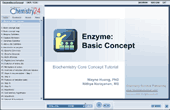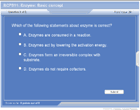Enzyme: Basic Concept
| Topic Review on "Title": |
Enzyme structure
An enzyme is a protein that catalyzes a chemical reaction and a substrate is a molecule which is acted upon by an enzyme. The substrate binds with the enzyme’s active site and the enzyme catalyzes the chemical reaction involving the substrate. The active site is the location on the surface of the enzyme where the catalysis of chemical reaction takes place. A Peptide bond is formed by amino acid condensation. Substrate is held by weak interactions at the binding site of the enzyme. Reaction catalysis and product formation occurs at catalytic site of the enzyme.
Mechanism of enzyme action
Several steps of enzyme action results in the formation of products and eventually the enzyme is regenerated. In lock and key hypothesis, enzyme holds the substrate as a lock holding the key. As per induced fit hypothesis, active site expands and contracts on substrate interaction.
How enzymes Act as Biocatalysts
Activation energy is the amount of energy required to convert all the reacting substances from ground state to transition state. It determines the rate of reaction. Enzymes work by lowering the activation energy. Lower the activation energy, faster is the rate.
Enzyme cofactors
Cofactor of an enzyme is the non-protein component and is essential for its catalytic activity. Coenzyme is a loosely bound organic cofactor that is required for enzyme activity. Prosthetic group is a metal ion or an organic compound that is covalently bound to an enzyme required for its activity. Activators are inorganic ions working as cofactors. They are either loosely or firmly bound.
Enzyme properties
Enzyme specificity is the ability of an enzyme to discriminate among competing substrates for it. There are four different types of specificity: Absolute, group, linkage, stereo chemical specificity.
|
| Rapid Study Kit for "Title": |
| Flash Movie |
Flash Game |
Flash Card |
| Core Concept Tutorial |
Problem Solving Drill |
Review Cheat Sheet |
 |
 |
 |
|
| "Title" Tutorial Summary : |
An enzyme is a protein that catalyzes a chemical reaction and a substrate is a molecule which is acted upon by an enzyme. The substrate binds with the enzyme’s active site and the enzyme catalyzes the chemical reaction involving the substrate. The active site is the location on the surface of the enzyme where the catalysis of chemical reaction takes place. A Peptide bond is formed by amino acid condensation. Several steps of enzyme action results in the formation of products and eventually the enzyme is regenerated. There are two hypotheses to explain enzyme substrate complex formation, Lock and Key and Induced Fit hypotheses. An enzyme cofactor is the non-protein component of an enzyme essential for its activity. Specificity is the ability of the enzyme to discriminate among competing substrates for it.
|
| Tutorial Features: |
- Four concept maps to elaborate the concepts.
- Precise definitions and basic structures for clear understanding.
- Various steps in enzyme action with animations.
- Animated diagrams of Lock and Key and Induced Fit hypotheses.
- List of Inorganic ions as activators and enzymes.
- List of coenzymes and the groups transferred.
|
| "Title" Topic List: |
Enzyme Structure
- Introduction
- Discovery
- Definition
- Basic structure
- Peptide bond formation
- Active site features
Mechanism of Enzyme Action
- Overview
- Enzyme action steps
- Features of transition state
- Lock and Key hypothesis
- Induced fit hypothesis
How enzymes Act as Biocatalysts
- How enzymes work
- Activation energy
- Energy diagram – chemical reaction and catalyzed reaction
Enzyme Cofactors
- Definition
- Cofactors types
- Holoenzyme
- Activators and examples
- Coenzymes
- Prosthetic groups
Enzyme Properties
- Characteristic features
- Specificity
|
See all 24 lessons in college chemistry, including concept tutorials, problem drills and cheat sheets:
Teach Yourself Biochemistry Visually in 24 Hours |